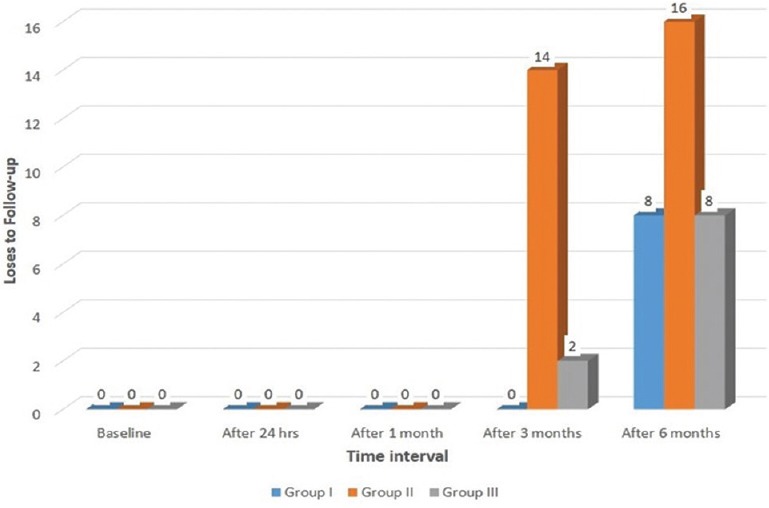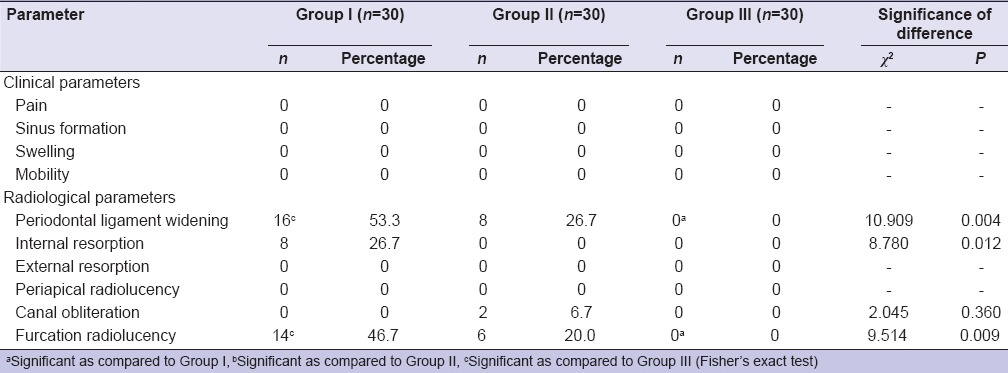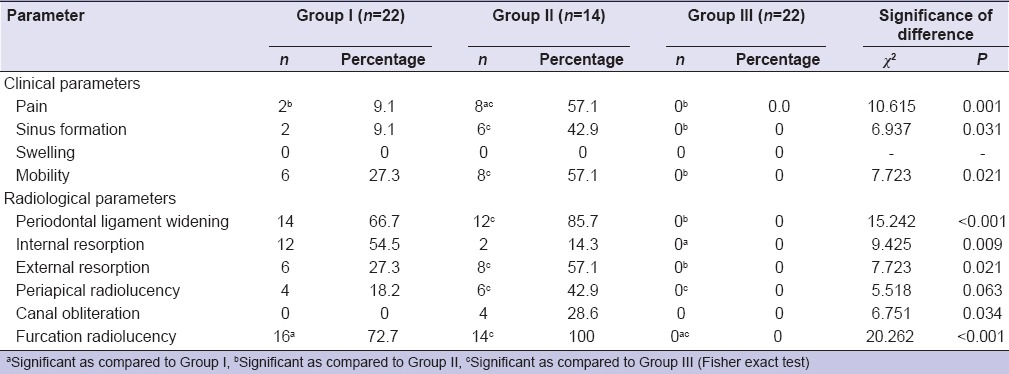Abstract
Objective:
To evaluate and compare the efficacy of ferric sulfate, glutaraldehyde, and mineral trioxide aggregate (MTA) as pulpotomy medicaments in primary molars.
Materials and Methods:
This was a perspective randomized clinical trial. A total of 90 molars from 42 children aged 4–8 years were selected for pulpotomy procedure. Teeth were randomly divided into three equal groups of 30 teeth each. Teeth in Group I were intended to be treated with ferric sulfate, Group II were intended to be treated with buffered glutaraldehyde and Group III with MTA. All the molars were evaluated clinically at 24 h and both clinically and radio graphically at 1, 3, and 6 months. The observations were statistically analyzed using Chi-square test and Fisher's exact test.
Results:
After 1 month, there was no clinical finding observed in all the three groups. At 3 months postoperative evaluation, 13.3% of teeth in Group I and 12.5% of teeth in Group II had mobility. At 6 months interval, pain and sinus formation each was noted in 9.1% of primary teeth in Group I while periodontal ligament widening was reported in 66.7% of teeth in Group I and 85.7% of teeth in Group II.
Conclusion:
MTA exhibited overall best results as pulpotomy agent for primary molars followed by 15.5% ferric sulfate, whereas 2% buffered glutaraldehyde was found to be least effective as a pulpotomy agent.
Keywords: Ferric sulfate, glutaraldehyde, mineral trioxide aggregate, primary molars, pulpotomy
INTRODUCTION
Natural primary teeth are considered as best space maintainers; hence every effort should be directed to preserve these teeth as far as possible. One of the most important goals of pediatric dentistry is the restoration and maintenance of carious primary teeth.[1]
Pulpotomy is performed in those primary teeth in which caries removal has resulted in mechanical pulp exposure.[2] Formocresol, a popular pulpotomy medicament based on the principle of devitalization, was considered as the gold standard in performing vital pulpotomy for primary teeth for the past 60 years.[3] However, in spite of years of success of its use, concerns had been raised about its potential toxicity, mutagenicity and carcinogenicity in humans.[4] A possible substitute for formocresol is glutaraldehyde which has been advocated because of its superior cross linking ability and better fixative property besides being less volatile causing less apical penetration with less dystrophic pulp calcification and more initial chemical activity than formocresol.[5]
Ferric sulfate was used in the study due to its hemostatic action, and since its time of application is only 30 s, it is very beneficial especially in case of children. However, the agglutinated proteins form plugs that occlude the capillary orifices.[6] Mineral trioxide aggregate (MTA), a relatively newer material, is composed of tricalcium oxide, tricalcium silicate, tricalcium aluminate, and silicate oxide. It is biocompatible, has high sealing ability, ability to form dentinal bridge and can cause regeneration of cementum and periodontal ligament (PDL).[7]
Due to scanty literature on comparative studies regarding the efficacy of various pulpotomy medicaments, the present study was undertaken to evaluate and compare the efficacy of ferric sulfate, glutaraldehyde, and MTA as pulpotomy medicaments in primary molars. The present study was planned in accordance with a previous study which evaluated the long-term effectiveness of four pulpotomy techniques in which pulpotomies using ferric sulfate revealed the best treatment outcome.[8]
MATERIALS AND METHODS
Ethical clearance and consent
The study was conducted in 2012 in DAV Dental College Yamuna Nagar, Haryana. Single independent investigator (PG) conducted all the procedures under the supervision of the study guide (IKP). Before the start of the study, ethical approval was obtained from the Institutional Ethics Committee for conducting the study. Informed consent was obtained from the parents of children before their final recruitment into the study.
Selection of patients and division of samples
Children in the age group of 4–8 years visiting the outpatient clinics in the Department of Pedodontics and Preventive Dentistry with a chief complaint of one or more decayed teeth were screened. Patients with any signs of internal or external resorption were excluded from the study. Finally 42 patients were included in the study. Sample size was calculated on the basis of the following formula.
n = 2 (Za + Z1− β) 2σ2, Δ2, where n is the required sample size.
Using simple random sampling, 90 primary molars from selected patients were divided equally into three groups. Teeth in different groups were intended to be treated with different pulpotomy agents-that is 15.5% ferric sulfate, 2% buffered glutaraldehyde, and MTA. Clinical and radiographic evaluations of the teeth were conducted at 24 h, 1 month, 3 months and 6 months, intervals by two independent examiners who had no knowledge of the group to which the particular tooth was assigned. Patients were assessed using different clinical and radiological parameters which were also used for future postoperative evaluations. The absence/presence of all the clinical and radiological signs was recorded. Before grading the X-ray films, the examiners were asked to evaluate 14 posterior periapical radiographs not included in the study to establish a consensus. Clinical parameters included pain, sinus formation, swelling (intra oral), and mobility while the radiological parameters included PDL widening, internal resorption, external resorption, periapical radiolucency, canal obliteration, and furcation radiolucency. The presence of each sign was recorded as a digital score of “1” and the absence was recorded as a digital score of “2.” The overall success of the treatment was assessed according to both clinical and radiographic findings.
Clinical procedure
Pulpotomy procedure was performed for the selected primary molars and different medicaments were then applied after coronal pulp removal.
Group I (Ferric sulfate): A sterile cotton pellet no. 4 moistened with 15.5% ferric sulfate (Astringedent - 60 ml; Ultradent products, USA) was placed in contact with the radicular pulp for 15 s. After irrigation with normal saline and observation of haemostasis, zinc oxide eugenol paste was applied on the pulp tissue.
Group II (2% buffered glutaraldehyde): After coronal pulp amputation, a sterile cotton pellet no. 4 moistened in 2% buffered glutaraldehyde solution (2% glutaraldehyde in 1 l with a solution activator of 6.5 g Bioclenz-G) was placed on amputated pulp stumps for 5 min. Cotton pellet was removed and zinc oxide eugenol paste was placed over the pulp stumps.
Group III (MTA): After obtaining hemostasis with sterile cotton pellets no. 4, pulp stumps were covered with a thin layer of MTA paste, which was prepared by mixing MTA powder with sterile saline at a 3:1 powder/saline ratio to obtain a thick, creamy consistency. The MTA base was placed on the floor of the pulp chamber and condensed against the pulp orifices with a moist cotton pellet. The cavity was then filled with zinc oxide eugenol.
Following pulpotomy, all the teeth were restored with stainless steel crown (3M)/light cure glass ionomer cement (GC Fuji I, GC America, Alsip, IL, USA) after 24 h. Children were recalled postoperatively after 24 h for clinical evaluation and after 1 month, 3 months and 6 months both for clinical and radiographical evaluation.
Statistical analysis
The recorded data was transferred to a personal computer and statistical analysis was carried out using SPSS package version 15 (SPSS Inc., Chicago, IL). Descriptive statistics were calculated using Chi-square test and Fisher's exact test. Statistical significance was set at P < 0.05.
RESULTS
At 24-h postoperative interval, none of the groups had presence of any clinical and radiological finding. In addition, at 1 month there was no clinical and radiological finding observed in all the three groups. After 3 months, 16 primary molars were lost to follow-up. This number increased to a total of 32 after 6 months [Figure 1]. At 24-h postoperative interval, none of the groups had presence of any clinical finding. At 1 month, there was no clinical finding observed in all the three groups. However, there was higher incidence of PDL widening and furcation radiolucency in Group I and Group II subjects as compared to Group III and the findings were statistically significant (P < 0.05) [Table 1].
Figure 1.

Losses to follow-up at various time intervals
Table 1.
Postoperative evaluation after 1 month interval

After 3 months evaluation, 13.3% of teeth in Group I and 12.5% of teeth in Group II had mobility but the findings were statistically insignificant (P = 0.369) [Table 2]. PDL was noticed in 73.3% of teeth in Group I and 62.5% of subjects in Group II and the findings were highly significant as compared to Group III (P < 0.001).
Table 2.
Postoperative evaluation after 3 months interval

After 6 months, evaluation was done, pain and sinus formation each was noted in 9.1% of primary teeth in Group I while mobility was noticed in 27.3% of teeth in Group I and 57.1% of teeth in Group II [Table 3]. No clinical finding was reported in teeth present in Group III. In radiological parameters, PDL widening was reported in 66.7% of teeth in Group I and 85.7% of teeth in Group II. However, furcation radiolucency was noticed in 100% of primary molars in Group II and findings were statistically significant when compared to Group III (P < 0.05).
Table 3.
Postoperative evaluation after 6 months interval

DISCUSSION
Primary molars treated with MTA showed 100% clinical success. Similar finding was observed in some other studies.[9,10] Pain after 6 months was reported in 57.1% patients treated with glutaraldehyde and only 9.1% patients treated with ferric sulfate. However, reports of some other study revealed greater clinical success (lesser no. of patients felt pain) with ferric sulfate.[11] The difference could be attributed to the dissimilar techniques and duration of study.
Success or failure of pulpotomy treatment is dependent upon an accurate diagnosis at the time of treatment. It is worth mentioning here that all the teeth included in the study were affected by caries. It is essential for the radicular pulp to be healthy at the time of treatment to increase the success rate of the procedure. Teeth treated with MTA did not show any sinus formation which could be due to its antibacterial properties. Some other studies also reported similar results.[9,12] Sinus formation was seen in only 9.1% cases of ferric sulfate. However, contradictory results were reported in some other studies conducted elsewhere.[8,13]
Absence of swelling on postoperative evaluations at all recall intervals in all groups is a clear parameter of success, proper case selection and maintenance of complete intra operative aseptic conditions achieving the proper hermetic seal. This finding is consistent with couple of other studies.[13,14] Tooth mobility was not observed in patients treated with MTA, whereas only 27.3% patients treated with ferric sulfate and 57.1% treated with glutaraldehyde showed tooth mobility at 6 months interval. This could be due to widening of PDL space.
MTA treated teeth did not show PDL widening due to its stimulatory effect on the biosynthetic activity of peri radicular cells. This was in accordance with another study.[15] Widening of PDL was observed in 66.7% of teeth treated with ferric sulfate and 85.7% teeth treated with glutaraldehyde after 6 months. This could be attributed to occlusal trauma or lack of bone support arising from advanced bone loss. Our findings were consistent with couple of other studies in which most common pathologic finding was PDL widening.[13,16]
In the current study, MTA treated teeth did not show internal and external resorption. Similar findings were observed in some other study in which MTA was used to treat internal resorption.[17] However, internal resorption was noted in pulpotomies performed with ferric sulfate pulpotomy (54.5%) and glutaraldehyde (14.3%). External resorption in case of patients treated with ferric sulfate and glutaraldehyde could be attributed to periapical inflammatory lesion which resulted in the loss of lamina dura around the apex.
Periapical radiolucency observed in cases of ferric sulfate and glutaraldehyde could be attributed to the release of bacteria and their toxins via the apical foramina.[18] In our study, MTA did not show any periapical radiolucency, which could be due to its biocompatibility and the resistance to bacterial penetration in the periapical areas.
Obliteration of the pulp canal was found in approximately one-third of the teeth treated with glutaraldehyde after 6 months in the present study which is also supported by some other study.[19] Furcation radiolucency was observed in more than 70% of teeth treated with ferric sulfate and all the patients treated with glutaraldehyde. These findings were consistent with other studies.[16,20] However, radiographic success with ferric sulfate was reported in some other study.[21] In our study MTA did not show any signs of furcation radiolucency which could be explained on the basis of hard tissue bridge formation due to its high sealing ability, biocompatibility, alkalinity and superior seal against bacteria.
To summarize, MTA was found to be a more successful medicament for cariously exposed primary molar as compared to 15.5% ferric sulfate and 2% buffered glutaraldehyde.
In order to come to conclusive results, a detailed longitudinal study involving larger follow ups is required and teeth need to be monitored until their physiological exfoliation. Moreover, studies involving large samples should be conducted to make the results more generalizable.
CONCLUSION
At the end of the study, it was observed that Group III (MTA) exhibited overall best results as pulpotomy agent for primary molars followed by 15.5% ferric sulfate, whereas, 2% buffered glutaraldehyde showed least favorable results both clinically and radiographically. However further larger sample size and longer observational period should be carried out to reach sound conclusion.
Financial support and sponsorship
Nil.
Conflicts of interest
There are no conflicts of interest.
REFERENCES
- 1.Corica A, Caprioglio A. Meta-analysis of the prevalence of tooth wear in primary dentition. Eur J Paediatr Dent. 2014;15:385–8. [PubMed] [Google Scholar]
- 2.Shirazi AS, Rezaifar M, Talebi M, Mortazavi A, Malekabadi KS. Application of bonding system as a sub-base material following electrosurgical pulpotomy treatment in primary teeth: A novel technique. Iran J Med Hypotheses Ideas. 2009;3:12. [Google Scholar]
- 3.Agamy HA, Bakry NS, Mounir MM, Avery DR. Comparison of mineral trioxide aggregate and formocresol as pulp-capping agents in pulpotomized primary teeth. Pediatr Dent. 2004;26:302–9. [PubMed] [Google Scholar]
- 4.Chandrashekhar S, Shashidhar J. Formocresol, still a controversial material for pulpotomy: A critical literature review. J Res Dent. 2014;2:114–24. [Google Scholar]
- 5.Havale R, Anegundi RT, Indushekar K, Sudha P. Clinical and radiographic evaluation of pulpotomies in primary molars with formocresol, glutaraldehyde and ferric sulphate. Oral Health Dent Manag. 2013;12:24–31. [PubMed] [Google Scholar]
- 6.Eidelman E, Holan G, Fuks AB. Mineral trioxide aggregate vs. formocresol in pulpotomized primary molars: A preliminary report. Pediatr Dent. 2001;23:15–8. [PubMed] [Google Scholar]
- 7.Farsi N, Alamoudi N, Balto K, Al Mushayt A. Clinical assessment of mineral trioxide aggregate (MTA) as direct pulp capping in young permanent teeth. J Clin Pediatr Dent. 2006;31:72–6. doi: 10.17796/jcpd.31.2.n462281458372u64. [DOI] [PubMed] [Google Scholar]
- 8.Huth KC, Hajek-Al-Khatar N, Wolf P, Ilie N, Hickel R, Paschos E. Long-term effectiveness of four pulpotomy techniques: 3-year randomised controlled trial. Clin Oral Investig. 2012;16:1243–50. doi: 10.1007/s00784-011-0602-3. [DOI] [PubMed] [Google Scholar]
- 9.Naik S, Hegde AH. Mineral trioxide aggregate as a pulpotomy agent in primary molars: An in vivo study. J Indian Soc Pedod Prev Dent. 2005;23:13–6. doi: 10.4103/0970-4388.16020. [DOI] [PubMed] [Google Scholar]
- 10.Holan G, Eidelman E, Fuks AB. Long-term evaluation of pulpotomy in primary molars using mineral trioxide aggregate or formocresol. Pediatr Dent. 2005;27:129–36. [PubMed] [Google Scholar]
- 11.Farrokh Gisoure E. Comparison of three pulpotomy agents in primary molars: A randomised clinical trial. Iran Endod J. 2011;6:11–4. [PMC free article] [PubMed] [Google Scholar]
- 12.Farsi N, Alamoudi N, Balto K, Mushayt A. Success of mineral trioxide aggregate in pulpotomized primary molars. J Clin Pediatr Dent. 2005;29:307–11. doi: 10.17796/jcpd.29.4.n80t77w625118k73. [DOI] [PubMed] [Google Scholar]
- 13.Casas MJ, Kenny DJ, Johnston DH, Judd PL. Long-term outcomes of primary molar ferric sulfate pulpotomy and root canal therapy. Pediatr Dent. 2004;26:44–8. [PubMed] [Google Scholar]
- 14.Huth KC, Paschos E, Hajek-Al-Khatar N, Hollweck R, Crispin A, Hickel R, et al. Effectiveness of 4 pulpotomy techniques – Randomized controlled trial. J Dent Res. 2005;84:1144–8. doi: 10.1177/154405910508401210. [DOI] [PubMed] [Google Scholar]
- 15.Torabinejad M, Pitt Ford TR, McKendry DJ, Abedi HR, Miller DA, Kariyawasam SP. Histologic assessment of mineral trioxide aggregate as a root-end filling in monkeys 1997. Int Endod J. 2009;42:408–11. doi: 10.1111/j.1365-2591.2009.01556.x. [DOI] [PubMed] [Google Scholar]
- 16.Ranly DM, Garcia-Godoy F, Horn D. Time, concentration, and pH parameters for the use of glutaraldehyde as a pulpotomy agent: An in vitro study. Pediatr Dent. 1987;9:199–203. [PubMed] [Google Scholar]
- 17.Sari S, Sönmez D. Internal resorption treated with mineral trioxide aggregate in a primary molar tooth: 18-month follow-up. J Endod. 2006;32:69–71. doi: 10.1016/j.joen.2005.10.018. [DOI] [PubMed] [Google Scholar]
- 18.Caicedo R, Abbott PV, Alongi DJ, Alarcon MY. Clinical, radiographic and histological analysis of the effects of mineral trioxide aggregate used in direct pulp capping and pulpotomies of primary teeth. Aust Dent J. 2006;51:297–305. doi: 10.1111/j.1834-7819.2006.tb00447.x. [DOI] [PubMed] [Google Scholar]
- 19.Tsai TP, Su HL, Tseng LH. Glutaraldehyde preparations and pulpotomy in primary molars. Oral Surg Oral Med Oral Pathol. 1993;76:346–50. doi: 10.1016/0030-4220(93)90266-7. [DOI] [PubMed] [Google Scholar]
- 20.Fei AL, Udin RD, Johnson R. A clinical study of ferric sulfate as a pulpotomy agent in primary teeth. Pediatr Dent. 1991;13:327–32. [PubMed] [Google Scholar]
- 21.Yildiz E, Tosun G. Evaluation of formocresol, calcium hydroxide, ferric sulfate, and MTA primary molar pulpotomies. Eur J Dent. 2014;8:234–40. doi: 10.4103/1305-7456.130616. [DOI] [PMC free article] [PubMed] [Google Scholar]


